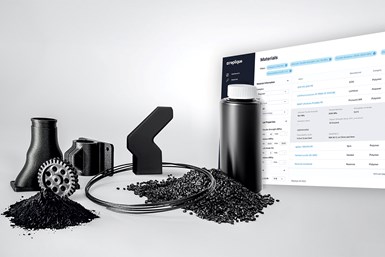Replique Announces Public Launch of 3D Printing Material Hub
Following a successful beta release, the Material Hub is now openly accessible to the broader additive manufacturing community. It contains a collection of more than 400 polymer materials which have been compiled in collaboration with more than 25 material providers.
Share
The Material Hub enables users to quickly find the right material according to their requirements. Source: Replique
Replique, provider of a decentralized 3D printing platform for the secure and reliable production of industrial-grade parts, has launched an extensive public Material Hub for 3D printing which is now open to the public following beta testing. After the successful beta release, which the company says received overwhelmingly positive feedback, Replique is now introducing the database to the broader additive manufacturing (AM) community.
The Material Hub is now openly accessible and contains a collection of more than 400 polymer materials, compiled in collaboration with more than 25 material providers. This marks a substantial increase, more than doubling the number of available materials since its initial introduction in November 2023.
Already in the beta phase, the hub helped numerous companies, institutions and partners to access and filter options for the right 3D printing materials in seconds.
“Replique’s Material Hub significantly accelerates the material selection process,” says Mathilde Lepilliez, Alstom innovation manager and 3D printing engineer. “Just recently, we have searched for a material that fulfills our high flame-retardancy requirements as part of a new 3D printing project. Thanks to Replique’s support we were able to find the right material fast and efficiently. This Material Hub will become a part of our daily-basis tools to help us to develop 3D printing.”
Replique says the Material Hub offers a variety of benefits and features to engineers, purchasers and R&D. Users can easily navigate the hub because of the technical filtering options to find the ideal materials for their specific applications, saving time and costs associated with manual research. Detailed technical specifications, industry standards and application fields are provided for each material, ensuring informed decision-making.
Additionally, printer manufacturers, service providers and other stakeholders can benefit from the collective knowledge within the database, fostering collaboration and innovation within the 3D printing community.
With the public launch, Replique has incorporated performance improvements based on user feedback, including an optimized search function. This enables users to either search on a detailed level, such as direction-dependent mechanical properties or on a more beginner-friendly level. Thus, also enabling less-experienced users to use the tool efficiently and get a head start on their adoption of AM. Once a suitable material is identified, users can also directly request a quote to get their parts produced through Replique or reach out to the material provider to clarify further details.
“We are thrilled with the positive reception of our Material Hub during the beta phase,” says Dr. Max Siebert, Replique co-founder and CEO. “The public launch marks an important step in our mission to democratize access to additive manufacturing. We are committed to continuously enhancing the platform to meet the evolving needs of our users.”
In the future, Replique plans on expanding the hub’s capabilities by adding more features and materials. While the current focus is on polymers, adding metal materials is already planned. Material providers interested in showcasing their materials are encouraged to reach out to Replique directly.
Related Content
Drones Take Flight with Metal and Polymer 3D Printed Parts: The Cool Parts Show Bonus
Drones produced by Cobra Aero now incorporate many 3D printed parts made through laser powder bed fusion and Multi Jet Fusion processes.
Read MoreHow to Build 10,000+ Shot Molds in Hours
Rapid tooling isn’t so rapid when it takes days to 3D print a metal mold, and then you still must machine it to reach the necessary tolerances. With Nexa3D’s polymer process you can print a mold in hours that is prototype or production ready and can last for more than 10,000 shots.
Read More8 Cool Parts From RAPID+TCT 2022: The Cool Parts Show #46
AM parts for applications from automotive to aircraft to furniture, in materials including ceramic, foam, metal and copper-coated polymer.
Read MoreThis Drone Bird with 3D Printed Parts Mimics a Peregrine Falcon: The Cool Parts Show #66
The Drone Bird Company has developed aircraft that mimic birds of prey to scare off problem birds. The drones feature 3D printed fuselages made by Parts on Demand from ALM materials.
Read MoreRead Next
To Improve Performance of Compression Molded Composites, Add 3D Printed Preforms
9T Labs' Additive Fusion Technology enables the manufacture of composite structures with as much or as little reinforcement as is necessary, using 3D printed continuous fiber preforms to add strength just where needed.
Read MoreGE Additive Rebrands as Colibrium Additive
As part of the brand name transition, both the Concept Laser and Arcam EBM legacy brands will be retired.
Read MoreVideo: Intelligent Layering Metal 3D Printing at 3DEO
Contract manufacturer 3DEO delivers metal parts using Intelligent Layering, a binder jetting-like 3D printing process the company developed and operates internally. Here’s how it works.
Read More












